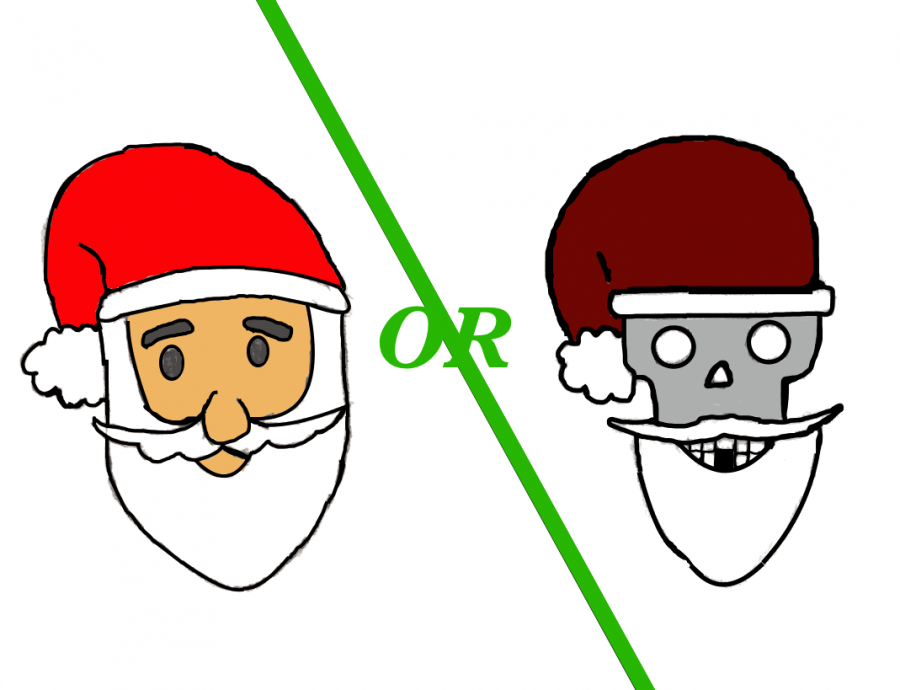Magical myths: innocuous or inimical?
December 14, 2017
As the holiday season draws near, so do all of the festivities associated with it. The smell of brownies baking permeates the air, holiday music firmly lodges itself in ears everywhere and grotesque sweaters are suddenly socially acceptable garments. And whether you celebrate Christmas or not, it is impossible to avoid the elderly, objectively odd man who sneaks into houses at night and keeps a large dwarf army in his secluded tundra lair: Santa Claus.
Santa, in the American tradition, is a jolly old man who lives in the North Pole alongside his helper elves and delivers presents while flying a seven-reindeer sleigh on Christmas Eve. Supposedly omniscient, he can apparently tell when one is asleep or awake and thus creates “nice” and “naughty” lists to determine who receives a present.
Almost every young child in the United States knows the story, and almost all of them find that their ideals of reality are shattered when they realize that he doesn’t exist. A similar phenomenon transpires with the tales of the tooth fairy and the Easter Bunny, which, although not as widespread as Santa, have a similar effect on children when they are revealed to be fabrications.
So, the question arises: Why do we present these fairy tales as fact to children? Although the enchanting and magical plots inherently evoke a visceral response of joy, they would function comparably if posed as what they really are—fairy tales. Parents do not hesitate to divulge that Cinderella or Snow White are works of fiction, yet they continue remain popular after hundreds of years. Accordingly, if the story of Santa was told as a fantastical tale, it would preserve the long-standing tradition while eschewing the deceit usually associated. Gifting would continue to be the popular practice it is today, evidenced by the countless gift exchanges between adults who—hopefully—are aware that Santa is a myth.
Still, trying to provide a vision of a utopian fantasy to toddlers can seem like a kindness, an attempt to preserve their innocence for as long as possible. However, the sheer despair in a child’s eyes when they realize that there is no fairy exchanging their broken teeth for money is enough to overshadow any notion of prolonging childlike naiveté. Moreover, it is often another child who, after finding out that these are mythical folk tales, takes upon themselves the responsibility of gleefully informing every classmate. When one of these kids arrives home and a parent is forced to admit the truth, whether regarding the Easter Bunny, tooth fairy or Santa Claus, they grasp the idea that their parents can lie, creating a level of distrust. A young brain, unable to discern white lies from full-blown deception, may even learn that it is okay to trick others and fabricate stories from such an incident, which negates many of the lessons that we, as a society, try to instill.
So, perhaps we should all consider straying away from presenting these tall tales as fact, instead passing tradition on by telling them as the fun, imaginative stories they are.


















![“[Building nerf blasters] became this outlet of creativity for me that hasn't been matched by anything else. The process [of] making a build complete to your desire is such a painstakingly difficult process, but I've had to learn from [the skills needed from] soldering to proper painting. There's so many different options for everything, if you think about it, it exists. The best part is [that] if it doesn't exist, you can build it yourself," Ishaan Parate said.](https://harkeraquila.com/wp-content/uploads/2022/08/DSC_8149-900x604.jpg)




![“When I came into high school, I was ready to be a follower. But DECA was a game changer for me. It helped me overcome my fear of public speaking, and it's played such a major role in who I've become today. To be able to successfully lead a chapter of 150 students, an officer team and be one of the upperclassmen I once really admired is something I'm [really] proud of,” Anvitha Tummala ('21) said.](https://harkeraquila.com/wp-content/uploads/2021/07/Screen-Shot-2021-07-25-at-9.50.05-AM-900x594.png)







![“I think getting up in the morning and having a sense of purpose [is exciting]. I think without a certain amount of drive, life is kind of obsolete and mundane, and I think having that every single day is what makes each day unique and kind of makes life exciting,” Neymika Jain (12) said.](https://harkeraquila.com/wp-content/uploads/2017/06/Screen-Shot-2017-06-03-at-4.54.16-PM.png)








![“My slogan is ‘slow feet, don’t eat, and I’m hungry.’ You need to run fast to get where you are–you aren't going to get those championships if you aren't fast,” Angel Cervantes (12) said. “I want to do well in school on my tests and in track and win championships for my team. I live by that, [and] I can do that anywhere: in the classroom or on the field.”](https://harkeraquila.com/wp-content/uploads/2018/06/DSC5146-900x601.jpg)
![“[Volleyball has] taught me how to fall correctly, and another thing it taught is that you don’t have to be the best at something to be good at it. If you just hit the ball in a smart way, then it still scores points and you’re good at it. You could be a background player and still make a much bigger impact on the team than you would think,” Anya Gert (’20) said.](https://harkeraquila.com/wp-content/uploads/2020/06/AnnaGert_JinTuan_HoHPhotoEdited-600x900.jpeg)

![“I'm not nearly there yet, but [my confidence has] definitely been getting better since I was pretty shy and timid coming into Harker my freshman year. I know that there's a lot of people that are really confident in what they do, and I really admire them. Everyone's so driven and that has really pushed me to kind of try to find my own place in high school and be more confident,” Alyssa Huang (’20) said.](https://harkeraquila.com/wp-content/uploads/2020/06/AlyssaHuang_EmilyChen_HoHPhoto-900x749.jpeg)







